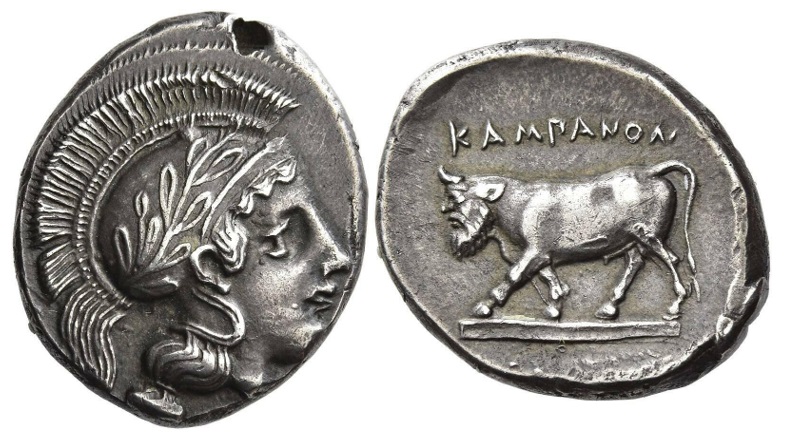Capua (Campanian mercenaries), silver, didrachms (Athena/man-head bull) (415-400 BCE)
From SILVER
415 BCE - 400 BCE Silver 913 kg
Description
| ObverseInscription or printing placed on the obverse.: | Head of Athena r., wearing crested Athenian helmet decorated with olive wreath. |
| ReverseInscription or printing placed on the reverse.: | KAMΠANON (Greek).Man-headed bull walking l. |
Mint and issuing power
| MintIdentifies the place of manufacture or issue of a numismatic object.: | Capua | Ancient regionAncient region.: | Campania | Modern countryModern country: Italy | AuthorityIdentifies the issuing power. The authority can be "pretended" when the name or the portrait of X is on the coin but he/she was not the issuing power. It can also be "uncertain" when there is no mention of X on the coin but he/she was the issuing power according to the historical sources: | Campanian mercenaries |
Chronology
| FromIdentifies the initial date in a range assigned in a numismatic context. | 415 BCE | toIdentifies the final date in a range assigned in a numismatic context.. | 400 BCE | PeriodTime period of the numismatic object.: Classical 480-323 BC |
Physical description
| MetalThe physical material (usually metal) from which an object is made.: | Silver |
Median weightMedian of the weights of numismatic objects (in grams). in grams | 7.20 | DenominationTerm indicating the value of a numismatic object. Examples: tetradrachm, chalkous, denarius.: | didrachm |
StandardStandard.: |
Image

Caua.jpg [1]
References
| Die study referencePublication of the study: | Campana 2010b1Campana 2010b, p. 42-49 | ||
| Coin series referenceReference to coin series study: | HN Italy2HN Italy, n° 477-478 | ||
| Coin series web referenceCoin series web references: | |||
Obverse dies distribution
| FrequencyFrequency of specimen in distribution. ᵖ | Number of obversesNumber of obverse dies. ᵖ (o) | % (o) | Number of coinsNumber of coins. (n) | % (n) | Die nameName(s) of the die(s). |
| 2 | 2 | 33.33 | 4 | 9.76 | 7, 8 |
| 3 | 1 | 16.67 | 3 | 7.32 | 4 |
| 7 | 1 | 16.67 | 7 | 17.07 | 6 |
| 10 | 1 | 16.67 | 10 | 24.39 | 5 |
| 17 | 1 | 16.67 | 17 | 41.46 | 3 |
| Total | 6 of 6 | 100.01 | 41 of 41 | 100 |
Reverse dies distribution
no distribution is available
Quantification
| Number of obversesNumber of obverse dies. ᵖ (o) | 6 | Number of singletons (o1)The number of singleton coins. ᵖ | 0 |
| Number of reverse diesNumber of reverse dies. (r) | 8 | Number of coinsNumber of coins. (n) | 41 |
| Coins per obverse dieNumber of coins per obverse die. (n/o) | 6.83 | Coins per reverse dieNumber of coins per reverse die. (n/r) | 5.13 |
| Reverse per obverse ratioRatio of obverse dies divided by reverse dies. (r/o) | 1.33 | Percentage of singletons (o1)number of coins (n) divided by the number of singletons (o1) ᵖ | 0 % |
| Original number of dies (O) (Carter 1983 formula)The estimation of the number of coins according to Carter 1983 ᵖ | 6.34 | Coins struck if 20,000 as average productivity per dieCoins made if the average productivity for obverses (according to Carter) is 20,000. ᵖ | 126,800 |
| Original number of dies (O) (Esty 2011 formula)The estimation of the number of coins according to the singleton formula in Esty 2011 ᵖ (O) | 7.03 | Survival rate if 20,000 as average productivity per dieSurvival rate if average productivity is 20,000. ᵖ | 0.00032 |
| Coverage (o = % of O) (Esty 1984 formula)Esty 1984 - coverage (% of O) ᵖ (o = % of O) | 100% | Die productivity if survival rate 1/2,000Average productivity if survival rate is 1/2,000. ᵖ | 12,933.75 |
| Weight of silver (in kg) if 20,000 coins per die (O = Carter formula)Carter 1983 * Median weight * 20000 (*10 if gold or electrum) ᵖ | 913 kg <br /> 913 kg | Die productivity if survival rate 1/5,000Average productivity if survival rate is 1/5,000. ᵖ | 32,334.38 |
Remarks
Most likely one single workstation Likely military